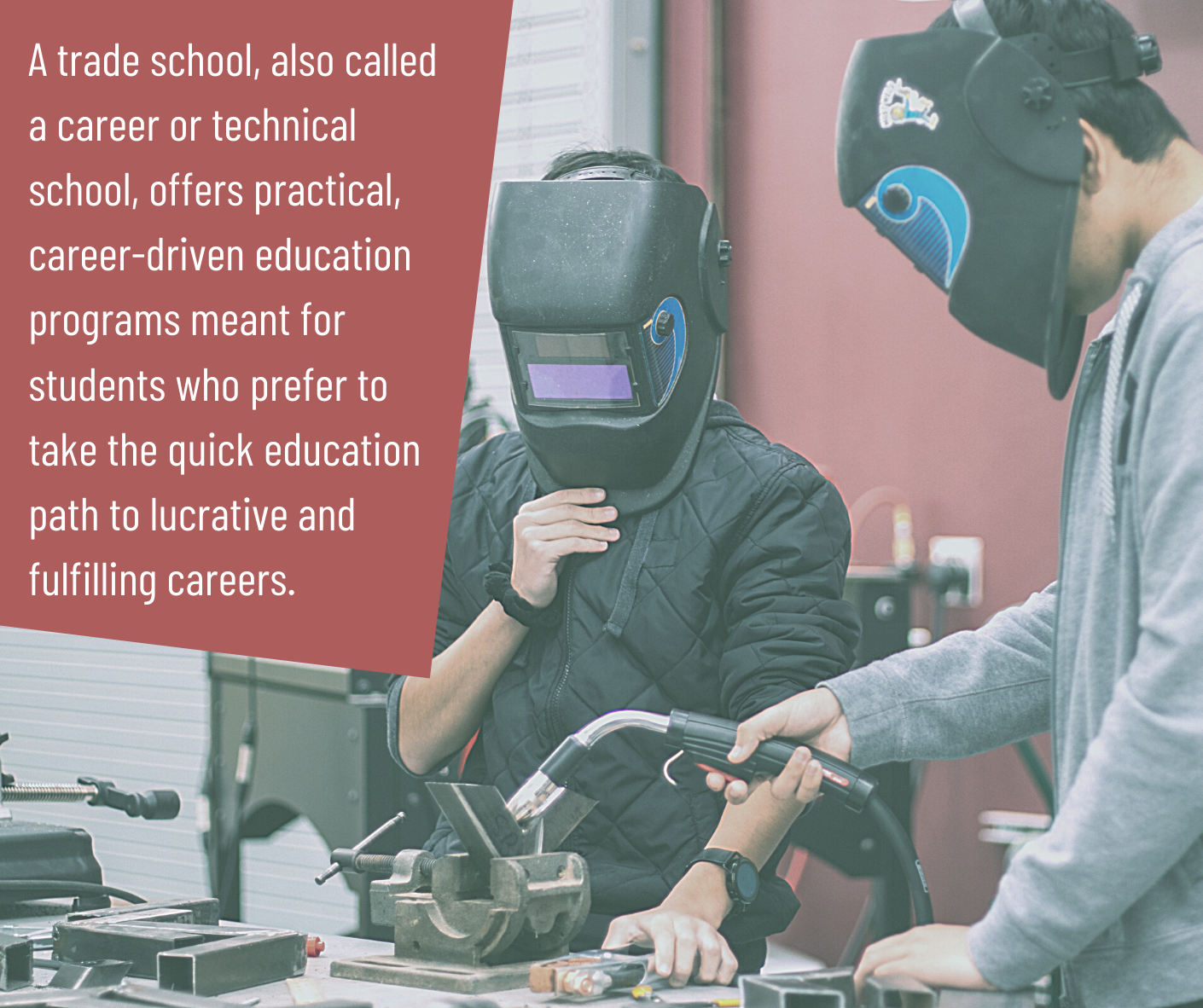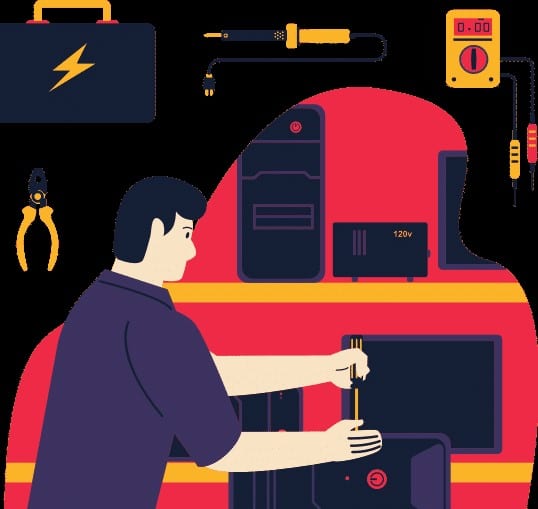A trade school, also called a career or technical school, offers practical, career-driven education programs meant for students who prefer to take the quick education path to lucrative and fulfilling careers. They have curricula that focus on particular essential knowledge and skill set needed for a career instead of general education. Their diploma and certificate programs are usually nonacademic and therefore take less time to complete.
Trade schools have long been disfavored and underrated. Most Americans view skilled trade jobs as dirty or unfulfilling. A survey has been set out with results implying more people have no interest in attending trade school. This is due to the lack of information in today’s job market and the demand for more skilled trade workers. Despite this, trade schools have now been slowly gaining popularity as more and more students look for short-term post-secondary programs that will get them a job. They have reached out to form partnerships and collaboration with companies that need to fill the shortfall of skilled workers.

Trade schools offer opportunities to high school graduates and those that want to upgrade skills in their jobs. For a lot of people, going to a trade school is more convenient and affordable than attending college. This does not imply that college is not essential. Just like a trade school, college isn’t everybody’s cup of tea. Some people stand out in hands-on setup while others find interest in a more academic setting. A thriving economy needs both products of higher education and skilled trained workers.
See also: Highest Paying Trade School Careers and Jobs and 50 Trades You Can Learn Online
Evidence suggests that approximately 6.2 million jobs out there await skilled trades that most baby boomers have retired from already. The Associated General Contractors of America (AGC) has reported that 80% of construction firms could not find quality workers fit for the industry. There are more skilled job openings than workers to fill them.
The U.S. Bureau of Labor and Statistics also says construction and extraction workers are paid an average of $47,430, which is higher than the median wage for all occupations. This only means that students have to include trade jobs among their career options. Trade jobs like any other profession can bring you high-paying, fast-growing, and rewarding careers. Skilled trade jobs offer, if not the same, more benefits than most white-collar jobs.
Essential Links
- Are trade schools worth it?
- How do online trade schools work?
- What are the advantages of attending a trade school?
Are trade schools worth it?
Besides making a good living, there are a few more benefits you need to know. The cost of reaching a career in skilled trades is a lot cheaper than college. It is also more convenient to apply for grants, loans, and even scholarships when you enroll at a trade school. This means less burden when you finish school and training.
Another reason why trade schools are worth your while is that it takes a shorter time to earn your diploma or certificate. You can earn income after two years in school. It is all the more worthwhile when trade schools let you gain experience immediately. If you are one of those that do not perform well inside the classroom, then trade school can get you to the hands-on experience in no time. You immediately get to learn from and work with skilled professionals at the same time.
Online trade and vocational schools are worth it!
It is evident that trade schools, in general, bring significant benefits to students. So, what about individuals who can’t afford to go to school because of their busy schedules? Or those that live in far-fetched areas who want to explore more job opportunities? The answer is online trade schools. As new technology continues to rise, the need for online education increases. Trade schools and colleges that offer vocational education have been undertaking steps to introduce online platforms to their students.
How Do Online Trade Schools Work?
Trade schools are increasingly seeking out digital innovations to serve their students. An effective way to quickly share and deliver online courses to students is through learning management systems like Moodle, Blackboard, and Desire2Learn. Students and teachers can log in and form discussions, engage in debate, share ideas, and talk about recent assignments. Some technical schools and community colleges that offer online trade programs let students access videos, images, and documents through digital libraries.

In other online trade schools, mobile apps are popular for tracking all of the school’s services and resources useful for both faculty and students. With functional apps, students can easily register for classes, and online trade schools can send out notifications to their students without having to meet them in the office. Another online digital tool that schools are using is the degree map where students can plan their courses, schedule, track cost, and requirements. This provides timely intervention for students and is a great way to monitor their progress. When you encounter technical difficulties, usually help desk are available 24/7 or on a schedule depending on the school. Online trade school courses can be as tricky as on-campus programs, but being able to access these types of technology will increase your chances of success.
What are the advantages of attending a trade school?
The many advantages of completing trade school diplomas or certifications online will make you consider taking this route. Here is a list of the reasons why online trade schools are worthwhile:
Demand for well-paying skilled trade jobs
There have been quite a few state legislatures that were considering solutions for the shortage of skilled trade workers. They aim to increase skilled trade workers by introducing programs that would encourage students to apply to trade and technical schools. Some states require education commissioners to collaborate with industries for more apprenticeship programs. In contrast, others propose that schools provide mentoring programs and on-site employment training to present more opportunities to its people. Depending on the occupation, skilled trades may require internships, apprenticeships, or on-the-job training. Let’s take a look at the jobs that significantly affect the economic growth of the country. The U.S. Bureau of Labor and Statistics has presented a projected growth (from 2018 to 2028) and median annual wage (as of May 2019) for each occupation related to skilled trades.
There’s an endless list of skilled trades which are all very important to the society.
Some of the common skilled trades jobs are:

Medical Technicians
Average Salary: $40,350 per year
Job Outlook: 11% (Much faster than average)

Paralegals and Legal Assistants
Average Salary: $51,740 per year
Job Outlook: 12% (Much faster than average)

Heating, Air Conditioning and Refrigeration Mechanics and Installers
Average Salary: $48,730 per year
Job Outlook: 13% (Much faster than average)

Plumbers
Average Salary: $55,160 per year
Job Outlook: 14% (Much faster than average)

Electricians
Average Salary: $56,180 per year
Job Outlook: 10% (Faster than average)

Carpenters
Average Salary: $48,330 per year
Job Outlook: 8% (Faster than average)

Welders
Average Salary: $42,490 per year
Job Outlook: 3% (Slower than average)

Painters and Construction Maintenance
Average Salary: $40,280 per year
Job Outlook: 6% (As fast as average)

Masonry Workers and Plasterers
Average Salary: $46,500 per year
Job Outlook: 11% (Much faster than average)

Machine Operators
Average Salary: $35,850 per year
Job Outlook: 4% (As fast as average)

Nursing Assistants and Orderlies
Average Salary: $29,640 per year
Job Outlook: 9% (Faster than average)

Paramedics
Average Salary: $35,400 per year
Job Outlook: 7% (Faster than average)

Hairdressers
Average Salary: $26,270 per year
Job Outlook: 8% (Faster than average)

Dental Hygienists
Average Salary: $76,220 per year
Job Outlook: 11% (Much faster than average)

Automotive Mechanics
Average Salary: $42,090 per year
Job Outlook: Little or no change

Pipefitters
Average Salary: $55,160 per year
Job Outlook: 14% (Much faster than average)

Machinists
Average Salary: $45,750 per year
Job Outlook: Little or no change

Bookkeepers
Average Salary: $41,230 per year
Job Outlook: Decline
Your earning potential does not solely depend on whether you have finished a college degree or not. Sometimes, it’s the actual occupation that matters!
Flexibility and Convenience
What makes online trade schools more appealing, especially to non-traditional students, is its flexibility and convenience. Students who try to fulfill family responsibilities and maintain busy schedules enjoy this learning opportunity. They don’t have to commute to the campus or try so hard to fit in with their schoolfellows. Many professionals also find online schools to be the absolute way to advance in the organization they work for. Online trade schools let students balance their careers and other responsibilities. Some students may be juggling parenting, work, and a career breakthrough making web-based education a must.

Depending on the trade school and learning objectives, online programs are split into two categories: Synchronous and Asynchronous learning. Synchronous courses utilize tools such as video conferencing, live streaming discussions, live chatrooms, and other virtual classrooms. It takes place in real-time with other learners online. This way of learning provides collaborative feedback, and learners get the answers to their questions immediately. On the other hand, asynchronous learning is an ideal way for non-traditional students. This is a more learner-centered approach since online courses are pre-recorded, sent through emails, posted online discussion boards, and social networking sites. Students will find this convenient, given that they don’t have to attend classes on a set time. This method of learning gives students the freedom to complete courses, take exams, and access documents on their own time.
Online trade schools have unlocked opportunities for those who are under-served. Not having to travel or commute to the school, being able to study whenever and wherever you are, and being able to focus on your studies at your convenience makes online trade school convenient.
Faster Way to A Diploma or Certificate
Online trade school programs only take a maximum of 2 years to complete. If your goal is to learn a specific trade, you need not waste your time with courses that have less or nothing to do with it. Depending on the trade school program you choose, you can finish courses in six weeks to two years. This is because most trade schools provide program-specific courses that will immediately lead you to real-world experience. You can either attend online trade school full-time or part-time, which will determine the length of the program.
Technology Advancements
Technology is transforming trade schools into developing better interactive courses and training methods. It allows trade schools to provide students broader learning skills and access to works and masterpieces outside the school and the country. Trade schools benefit from these advancements enabling them to expand their reach to potential students. It is rapidly changing and brings about new challenges and opportunities to the schools and learners. The increased use of laptops and devices has made accessing courses easier.

Online trade schools must ensure that their graduates are ready to take on the digital world. Teachers and trade school administrators must keep up with technology so that the training and simulation offered in the program are up-to-date and realistic. For this reason, industries and trade schools have to work together to give students an experience that is closer to the real world. Communities that collaborate with workforce systems and employers offer apprenticeship programs that utilize the latest technologies. Also, it would be ultimately cheaper for trade schools to have software that can mimic machine workings and get students trained with virtual reality lessons.
New technology has made it possible for businesses to create new processes for increased productivity and high-quality employment. Tasks are now efficiently performed with the help of intelligent machines. Workers in these businesses are required to learn new skills. It is only appropriate for trade schools to help future skilled trades workers prepare for this challenge.
It’s a great idea to start your new classes out in style. Are you in the market for a new laptop? If so, check this out: 17 Best Laptops for Trade School Students in 2020
Low-cost Education

One of the critical factors students ask for is the cost. How much does an online trade school cost? Tuition in most trade schools tend to be less expensive, and students get paid to do internships or apprenticeships. According to the College Board, trade or technical colleges charge $3,730 in fees, while public four-year institutions cost $26,820. In these challenging economic times, attending trade schools is the best option. What’s even better is that you can apply for financial aid or scholarships, but you won’t have to carry a heavy-duty loan to make it to your goal. You have fewer expenses to incur with online trade schools because they do not have to cost less to deliver online courses.
Unlike traditional college that lets students spend for room and board, campus security, student organizations, and campus recreation, online trade schools only have tuition, technology fees, and exam proctoring costs. There is also no need for more staff and support personnel to help you. With online trade schools, you do not have to spend on commuting or parking fees, textbooks, and other learning materials. Besides paying for tuition and other small fees, all you need for online trade schools are a reliable internet connection, relatively new device or a laptop, and strong time-management skills.
Small Classes and A Comfortable Learning Environment
You will notice in the beginning that you only have very few peers in an online trade school. This means you enter a class with like-minded people who may have the same interests and goals. When you belong to a small class, you will likely get more individual attention and better communication with your instructor. There is less interference since the instructor can cater to each student fully. No one gets left behind. Faculty will spend more time in reading your assignments, so you get more feedback on it.
Small classes also tend to bring more hands-on coursework or activities that enhance your learning experience. With only a few students attending, you get the chance to know them better and interact with them more through exchanging ideas, getting comments on presentations, and learning from one another. Many shy students will find more comfort in online classes so they can participate more easily in it than in physical class discussions. For those with attention issues, small classes can help them focus because there is less distraction, noise, or conflicts.
Do you need some tips for self-motivation? See our 8 Ways to Develop Self-Motivation for Online College Success resource article to help you stay focused!
Job Security

Online trade schools take pride in being able to send their students to work right after they complete the courses. Trade schools maintain strong ties with businesses in many industries. If you do well in completing your program, chances are, you could find a great job after you earn your certificate or diploma. So, they hire counselors to take care of finding jobs, internships, apprenticeships, and specific training for their students. Job placement is essential when looking for trade schools. This conveys the school’s dedication to helping you land a job and lead you to success.
Additionally, job security in skilled trades is high even since your new skill will never be obsolete. You can take additional classes to upgrade it. This will increase your potential and contribution to society.
Helps Develop Self-discipline
Online trade schools give you the freedom to choose the best time and place for learning. It also needs a certain level of independence. You can customize and set up your ideal learning environment. That freedom requires discipline. You do not just stop at organizing your courses online, but you have to accomplish all other responsibilities besides schoolwork. Instructors won’t be there to see you every day to see if you’ve been working on your courses, so it’s up to you to keep up and meet deadlines. This means eliminating distractions that drain your energy.
Online classes will require you to reach out to faculty and peers, and you should know when and how to do it. It takes discipline to know whether you’re overdoing or neglecting your responsibilities. By setting short- and long-term goals and establishing a routine that you would likely follow, you experience less stress and improve self-discipline.
Would you like more information? Check this out: Trade School vs. Community College: The Differences